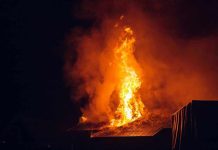
Michigan churches are locking their doors and posting guards after a deadly attack shattered the Grand Blanc community—forcing a reckoning with security and religious freedom that hits at the heart of American values.
Story Snapshot
- A deadly shooting and fire at a Grand Blanc church forced Michigan congregations to abandon their open-door traditions for urgent security measures.
- Churches statewide now lock doors and post guards during services, sparking debate over the balance between safety and spiritual openness.
- Attorney General Nessel warned of harsh penalties for false or copycat threats as anxiety spreads through religious communities.
- Experts urge multi-layered security while some faith leaders worry increased safeguards could erode the welcoming spirit of worship.
Deadly Attack Forces Michigan Churches to Rethink Security
On September 28, 2025, tragedy struck the Church of Jesus Christ of Latter-day Saints in Grand Blanc, Michigan, when a shooting and fire left multiple victims dead and injured. This unprecedented violence not only devastated the local congregation but sent shockwaves across the state. In the immediate aftermath, churches throughout Michigan enacted sweeping security changes—locking doors and posting guards during worship services and events—abandoning generations of open-door policy that once symbolized community and trust.
The rapid transformation in church security protocols reflects both the severity of the attack and the deep concerns over continued threats. Within days, Michigan Attorney General Dana Nessel publicly warned that anyone issuing false or copycat threats in the wake of the tragedy would face full legal consequences. The attorney general’s office coordinated closely with local law enforcement and church leaders, aiming to prevent further incidents and reassure a rattled public. For many faith-based communities, these new restrictions came with a heavy heart, as leaders weighed the need for safety against the cost to their traditional spirit of openness.
Traditions Collide with New Realities: Balancing Safety and Faith
Historically, Michigan’s churches—especially LDS congregations—embraced open-door policies to welcome worshippers and foster community bonds. The Grand Blanc attack, however, exposed the vulnerabilities of such trust-based traditions in an era of rising violence targeting places of worship nationwide. While prior incidents in Michigan were limited to threats or minor disruptions, the scale and brutality of the Grand Blanc assault marked a turning point. Now, surveillance cameras, security guards, and locked doors are becoming the norm, fundamentally altering the way congregations gather and interact.
Church leaders are motivated by the urgent need to protect their flocks and restore a sense of safety. Many express concern that the shift toward fortified worship spaces may come at the expense of community connection and spiritual warmth. Law enforcement agencies are working hand-in-hand with ministries to standardize safety measures, offering guidance on emergency planning and access control. These partnerships highlight the power dynamics at play, with state officials providing oversight while local congregations retain autonomy over daily operations. The collaboration aims to reassure both parishioners and the broader public that faith and security do not have to be mutually exclusive.
Broader Impacts and National Ripple Effects
The immediate impact of the Grand Blanc church attack has been a disruption of religious activities and a spike in anxiety among churchgoers. Families of victims and the wider faith community are grappling with grief and fear, while increased law enforcement presence at religious sites is becoming a new reality. The economic burden of enhanced security—from surveillance systems to paid guards—adds to the strain on congregations already facing declining attendance due to safety concerns.
Politically, the attack has intensified calls for legislative action on church safety. The debate now centers on how to strike a balance between protecting constitutional rights—especially freedom of religion—and defending communities from real threats. Notably, the response in Michigan has influenced churches in other states such as Texas, where similar security upgrades are underway. This national ripple effect underscores the vulnerability of religious spaces and the urgent need for comprehensive strategies to protect them against violence without sacrificing foundational American values.
Experts from the University of Michigan and security professionals agree: a multi-layered approach is essential. Recommendations include adopting surveillance, controlled access, and detailed emergency protocols. While some religious leaders voice concern over the erosion of community spirit, others argue these changes are necessary to ensure long-term safety and resilience. The consensus among credible voices is clear—the Grand Blanc attack marks a watershed moment in church security, demanding both vigilance and a renewed commitment to the principles that define American faith communities.
Sources:
Understanding Safety and Security at Places of Worship
Police Plan Extra Security at General Conference in Salt Lake After Church Shooting
Church Attack in Michigan: U-M Experts Available to Comment
AG Nessel Reminds Residents of the Consequences of False or Copycat Threats







